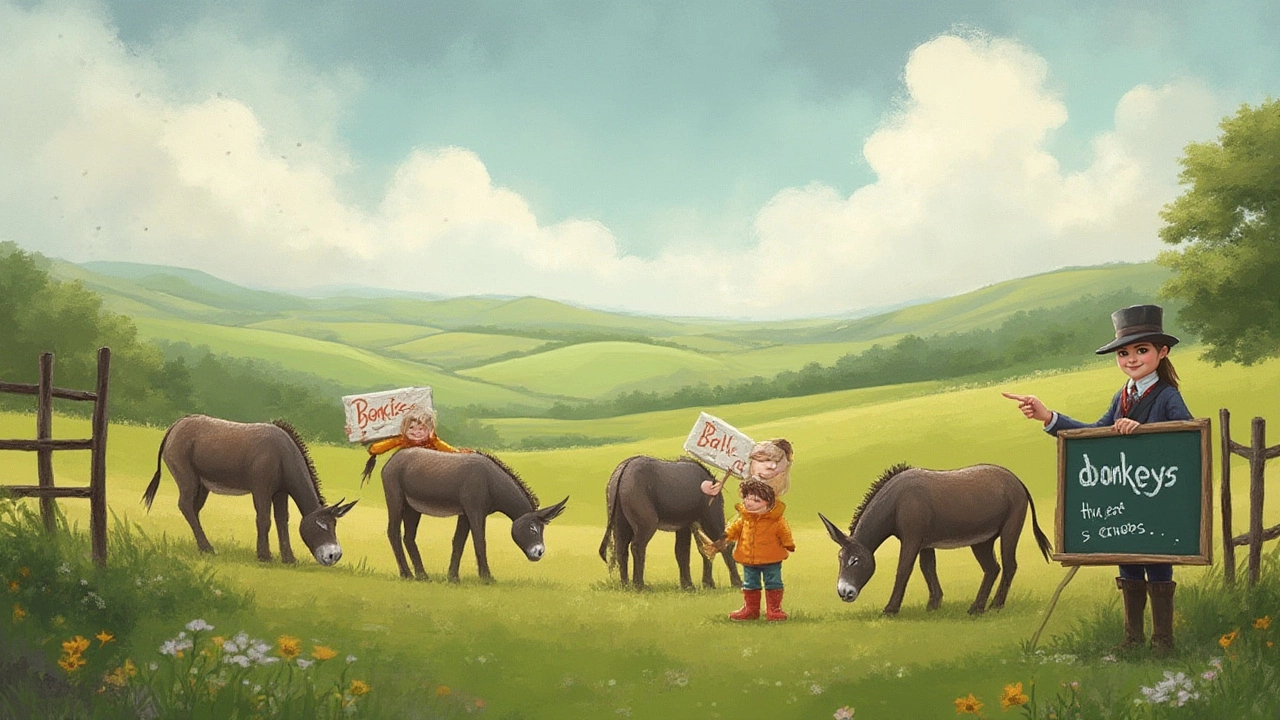Donkeys or Donkies? Discover the Plural of Donkey and Why It Matters
 Jul, 28 2025
Jul, 28 2025
English can drive you mad at the best of times. Think about it—the plural for "goose" is "geese," but if you try the same logic with "donkey," you end up with something that sounds almost wrong: "donkies." Weird, right? It’s no accident, either. Our language is chock-full of head-scratchers like this, where the expected rule just collapses under tradition or some obscure historical oddity. So, do you say donkies, donkeys, or maybe you gave up and just call them all "a group of donkeys" and move on? There's actually a very concrete answer, and the story behind it is way weirder and more interesting than anyone expects. Let's untangle this little grammar puzzle and see what it reveals not just about donkeys, but about how we use and twist English day to day.
The Right Plural: Donkeys, Not Donkies
This is the one fact you want to walk away with: the plural of "donkey" is donkeys. No tricky spellings, no funny business with the letter "y". This is, honestly, the opposite of what many expect when they remember words like "puppy" (puppies) or "city" (cities). The big rule we’re taught goes like this: if a noun ends in a consonant plus “y,” you replace "y" with "ies". So why do we say "donkeys" and not "donkies"? It's all about that innocent looking vowel right before the "y." For words where a vowel comes right before the "y"—like “donkey,” “key,” or “boy”—you just tack on an “s.”
If you want a quick cheat sheet, here you go:
- Ends in consonant + y: change “y” to “ies” — e.g., “sky/skies,” “puppy/puppies”
- Ends in vowel + y: just add “s” — e.g., “toy/toys,” “monkey/monkeys,” “donkey/donkeys”
This rule explains a lot of everyday words. So next time you're second-guessing yourself, check what comes right before the "y." That letter holds the key to unlocking the plural mystery.
Why Do Some Words Change "Y" to "IEs"?
The "y" problem isn’t just random. It’s tied into how we pronounce and build words in English. With words ending in a consonant followed by “y,” like “baby” or “activity,” speaking “babys” or “activitys” just feels wrong. Try saying them out loud—they don’t roll off the tongue smoothly. Swapping “y” for “ies” makes the word easier to pronounce, keeping the flow of speech. Adding an “s” after a vowel and then a "y," on the other hand, is way less awkward. This is why “donkeys” just feels right, even if your spell check tries to tell you otherwise.
Let’s look at how this stacks up—with a few examples.
| Singular | End Letter(s) | Plural Rule | Plural Form |
|---|---|---|---|
| Donkey | Vowel + y (ey) | Add "s" | Donkeys |
| Puppy | Consonant + y (py) | Change "y" to "ies" | Puppies |
| Key | Vowel + y (ey) | Add "s" | Keys |
| City | Consonant + y (ty) | Change "y" to "ies" | Cities |
| Monkey | Vowel + y (ey) | Add "s" | Monkeys |
This table nails it: it's not about the word itself, but the combo before the "y." If you memorize one rule about this, let it be this vowel/consonant + y rule—it’ll save you headaches down the road, especially with animals (think “turkey/turkeys,” not “turkies”).

What the Donkey Tells Us About English Plurals
Now, let’s be honest: English is notorious for making people second guess themselves—native speakers included. "Donkey" is just the tip of the iceberg. It’s actually a pretty logical word by our standards. A lot of other animal plurals are far less friendly. For example, who decided that one “goose” becomes “geese,” but one “moose” becomes “moose” (no change at all)? Or that we can have “ox/oxen” but not “box/boxen” (it’s boxes, if you were wondering)? No wonder everyone gets tripped up at some point.
But there’s a practical reason behind these curves and kinks: the history of English is a cocktail of different languages. Old English, Latin, French, Germanic — all left their fingerprints. For “donkey,” though, we stick with the reliable “add s” rule, thanks to that handy little vowel-before-“y” escape hatch.
Here’s a brief flavor of English animal plurals:
- Sheep → sheep (no change, so simple even a sheep could memorize it)
- Fish → fish or fishes (both correct, depending on context)
- Deer → deer (again, no change)
- Goose → geese (good luck guessing this any other way)
- Person → people (not even close)
It’s a mess, but it’s one you can navigate once you start noticing the patterns. The trick isn’t to memorize every single plural, but to spot the rules that hold up most of the time (and laugh at the ones that don’t).
Tips for Remembering the Plural of Donkey and Similar Words
If you’re someone who gets tripped up by plurals, you aren’t alone. But there are actually a few handy hacks that make “donkeys” and words like it stick. The first is the vowel rule—spot it, trust it. Whenever you see a vowel before the “y,” let your brain default to adding an “s.”
You can also build silly sentences or play word games—a lot of teachers recommend coming up with phrases like, “Monkeys and donkeys eat keys,” whenever you need a mental reminder. Visual learners love little rhymes: “If there’s a vowel before the y, just add s, give it a try!” It may sound goofy, but it does the trick.
Getting used to irregular plurals also helps. Run through short lists of common animal names and practice their singular and plural forms. Little routines like that lock it in.
- Break new words down by syllable and pay attention to that ending: is there a vowel hugging up against the “y”? If yes, just add "s".
- Flashcards with pictures work wonders. Write “donkey–donkeys” on one, “puppy–puppies” on another. See it, say it, remember it.
- Quiz yourself with fun fill-in-the-blank games. “I saw three ____ at the farm” – what feels right, “donkies” or “donkeys”?
- Find online grammar games that play with plurals. These sneak repetition into your day, and before you know it you’re spelling “donkeys” in your sleep.
- Challenge friends—drop tricky plurals into conversation and see who spots the mistake first. It’s kind of nerdy fun, especially after you’ve already nailed the rule.
Don’t overthink it. Some of the best language learners just read, watch, and listen a lot; the correct forms start to sound “right” almost by instinct. No shame in double-checking but next time you hit that plural and can’t remember the rule, look at what comes before the "y." If it looks like “donkey” or “turkey,” you’re safe just adding an “s.” The language might have its wild side, but this rule’s one spot where you can relax and trust your instinct—so, go forth, write about all the “donkeys” you please, and never sweat the spelling again.